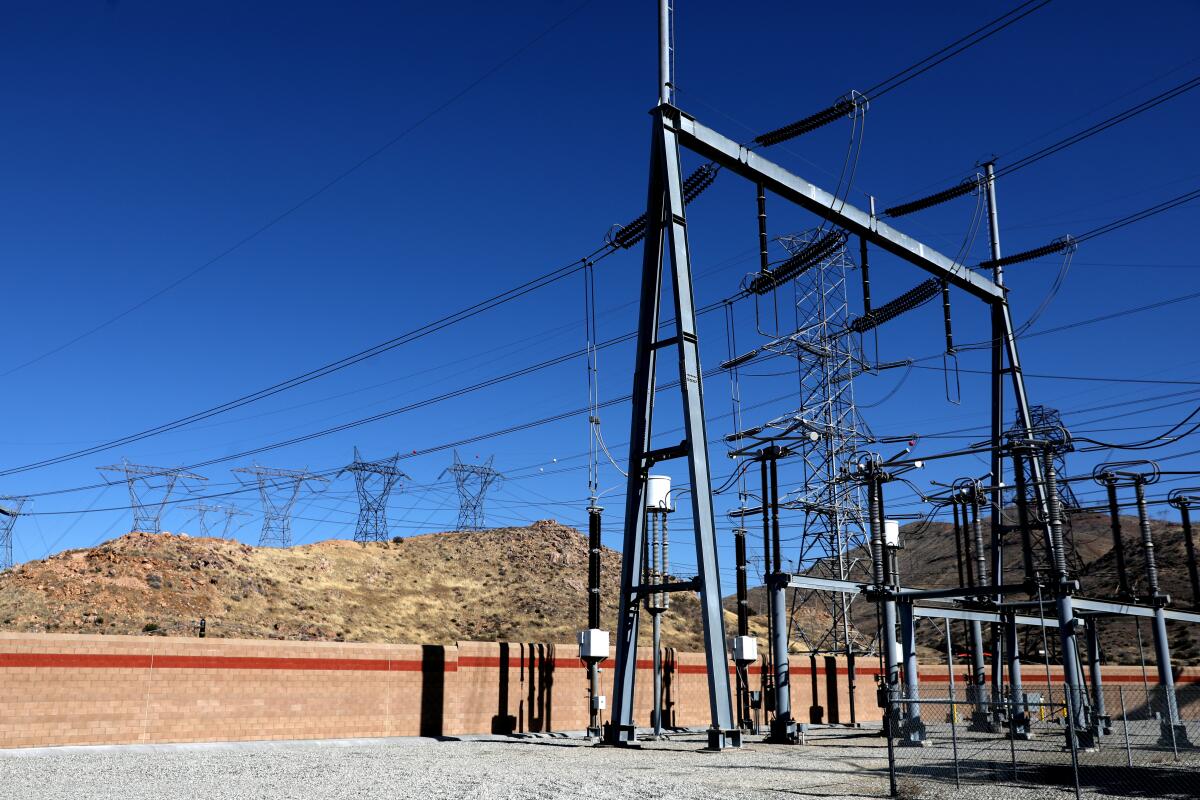Newsletter: How should utility companies spend your money? A debate rages

This is the May 13, 2021, edition of Boiling Point, a weekly newsletter about climate change and the environment in California and the American West. Sign up here to get it in your inbox.
Unless you’re an energy nerd like me, you probably don’t spend much time thinking about how utilities spend the money you pay them each month. You used a bunch of electricity or natural gas, and that’s what you’re getting charged for. Right?
Not quite! In addition to fuel costs, you’re also paying for repairs to old power plants, construction of electric wires and gas pipes, subsidies for energy-saving lightbulbs, discounts for low-income households, shareholder profit margins of about 10%...
And somewhere, buried so deep you might never know it, the cost of your utility’s memberships in trade associations.
Why does that matter? Because those industry groups take public policy stances that are sometimes controversial.
The Edison Electric Institute, for instance, says it supports clean energy but has at times supported groups that have opposed clean air rules. The American Gas Assn. has been involved with political efforts to block cities from banning gas appliances in new homes, a growing battleground as climate activists push for a nationwide transition to all-electric heating and cooking.
With those types of examples in mind, the Center for Biological Diversity is urging federal officials to make it harder for monopoly utility companies to charge customers for the costs of their trade association dues.
The Tucson-based advocacy group petitioned the Federal Energy Regulatory Commission in March. Dozens of companies and nonprofits have weighed in. It’s a fierce battle that could affect your power bills, and the power wielded by the utility industry.

A quick primer: Utility companies are only supposed to bill ratepayers for programs that benefit ratepayers (plus legally sanctioned profit margins). They can spend money on other stuff if they want to, but shareholders are supposed to pay for it.
Charging ratepayers for association dues has typically been considered kosher because these trade groups serve utility customers in numerous ways. They keep companies informed about emerging safety and environmental issues, offer employee training programs and regulatory updates, and coordinate planning for extreme storms and cybersecurity threats, among other tasks.
Lobbying costs have long been excluded. Under accounting rules developed by federal officials, utilities are required to charge shareholders, not ratepayers, for the portion of trade association dues that go toward lobbying.
But the Center for Biological Diversity says that system leaves room for companies to fudge the numbers — and lets them charge customers for advocacy activities that aren’t technically lobbying.
For an example of what this debate looks like in practice, see my reporting from 2019 on California’s Public Advocates Office, a consumer watchdog agency, questioning the expenditures of Southern California Gas Co., the country’s largest gas utility. The watchdog was skeptical about SoCalGas customers being forcing to fund trade groups that had promoted natural gas through Instagram campaigns and behind-the-scenes strategizing, even as California tried to reduce its dependence on fossil fuels.
“Using ratepayer funds to undermine the state’s interests and goals is inappropriate,” a watchdog official told me at the time.
SoCalGas and the industry groups had a different perspective. They argued that natural gas is cleaner than oil and coal and had a role to play in reducing emissions, and that customers would face higher costs from policies to phase out the fuel.
“SoCalGas supports organizations that provide benefits to our customers,” a company spokesperson told me.
The Center for Biological Diversity would require utilities to list all trade association dues on the side of the ledger paid for by shareholders. That way, the group says, the burden would be on companies to prove to state regulators which costs should instead be borne by ratepayers. Right now, consumer watchdogs and environmentalists must challenge costs they deem suspect.
The Center for Biological Diversity’s petition cites several media reports on trade association advocacy, including my aforementioned story detailing the American Public Gas Assn.’s “Gas Genius” Instagram campaign, which included softly lit images of families and millennials cooking on outdoor grills, enjoying warm baths and relaxing by roaring fire pits.
“That Instagram campaign, right now we have no idea how much it costs,” said Howard Crystal, an attorney who leads the center’s energy justice program. “Given all of the recent attention to these particular kinds of activities, people should be able to see what they are and how much they cost.”

The center’s petition has received support from organizations including the Sierra Club, the Nevada Bureau of Consumer Protection, the Utility Reform Network, the National Consumer Law Center and Climate Hawks Vote.
Several utility trade groups have pushed back, arguing no changes are needed to federal accounting rules.
The Edison Electric Institute said in written comments to the Federal Energy Regulatory Commission, or FERC, that the agency is being asked to “redefine lobbying activities to include activities...with which the Petition may disagree,” a job that belongs to Congress. The group said utility costs allocated to customers already face scrutiny, and that any “infrequent errors” in the way those expenses get divvied up “are identified through regular audit procedures and then rectified.”
I also spoke with Emily Fisher, EEI’s general counsel. She told me the proposed changes would make it difficult if not impossible for companies to get reimbursed for funding badly needed programs, such as getting the lights back on after storms and protecting utility workers from COVID-19. She suggested the Center for Biological Diversity is using “the guise of concern about customers and what they pay” as an excuse to stop industry groups from providing input on government policy.
Fisher also noted that planet-warming emissions from the electric power sector are 40% lower than they were in 2005.
“Our members are leading the clean energy transformation,” she said.
The American Gas Assn., meanwhile, described the proposed changes to accounting rules as “a solution in search of a problem,” telling FERC there is “no evidence suggesting that the current regulatory construct enables widespread accounting abuses.”
The group also said it does a great deal of work that benefits utility customers.
“Many of these services have nothing to do with lobbying and are directly related to improving safety, operational efficiencies, security, a company’s environmental footprint, and operator knowledge,” the trade association wrote.
Several other trade groups and utility companies have submitted comments to FERC opposing the proposed changes, including Duke Energy, National Grid, the Interstate Natural Gas Assn. of America and the Nuclear Energy Institute.
Utility companies don’t get as much attention as oil and gas giants like Koch Industries or Exxon Mobil, but they’re highly influential players in Washington, D.C., and across the country. And they often work closely with trade groups. The Edison Electric Institute had $91 million in revenues in 2018, while the American Gas Assn. reported revenues of nearly $62 million.
Even if utilities face greater scrutiny of how they spend customer money, that won’t necessarily stop them from spending shareholder money however they want. And it’s worth remembering there can be genuine disagreements about the best ways to fight climate change. Just because a company disagrees with an environmental group doesn’t mean its point of view is wrong.
But in an era of growing scrutiny of corporations, and their role in shaping policy, this battle isn’t going away soon. So it will be fascinating to see what FERC decides — whenever the notoriously slow-moving agency gets around to deciding.
Until then, here’s what’s happening around the West:
TOP STORIES
President Biden is moving ahead with a plan to protect 30% of U.S. lands and waters by 2030. The administration’s “30 by 30” vision involves working with Native American tribes, building urban parks and supporting voluntary conservation by farmers and ranchers, The Times’ Anna M. Phillips and Rosanna Xia report. Also this week, federal officials said they would restore protections for migratory birds and consider banning mining on 10 million acres of western lands to protect the greater sage grouse.
Southern California air quality officials approved first-of-their-kind rules that will require warehouse operators to help reduce pollution. That should result in more electric trucks rolling through Inland Empire communities sometimes called “diesel death zones,” my colleague Tony Barboza reports. In San Diego, regulators are looking at the new rules as a possible model for their own port, where there’s plenty of cancer-causing pollution, Joshua Emerson Smith reports for the San Diego Union-Tribune.
The trust responsible for paying out billions to Pacific Gas & Electric fire victims is spending tens of millions of dollars on lawyers and other administrative costs while only doling out small amounts to fire victims. That’s the takeaway from this story by KQED’s Lily Jamali, who writes that many fire survivors are stuck in financial limbo and struggling to get by.
WATER AND WILDLIFE
Forty-one of California’s 58 counties are facing a drought emergency, at least according to Gov. Gavin Newsom. Here’s the full list, via my colleague Faith E. Pinho. While conditions vary from place to place — Southern California was mostly excluded from Newsom’s latest drought declaration — there’s no question the state is in bad shape. That’s partly because the mediocre mountain snowpack we did get is quickly evaporating and seeping into the soil, as the Sacramento Bee’s Dale Kasler explains.
Weird stuff is happening along California’s coastline. The Times’ Susanne Rust reports that three gray whales have washed up dead in the San Francisco Bay, bringing the total number of decomposing whales found along the region’s shoreline to eight in just over a month. In Newport Beach, meanwhile, a creepy-looking anglerfish — the one with the lightbulb-like antennae extending from its head that you might remember from “Finding Nemo” — also washed up dead, Faith E. Pinho reports.
Another gray wolf journeyed from Oregon into California, and it’s a big deal. The Golden State’s wolves are slowly making a comeback after being wiped out a century ago, Lila Seidman writes, exciting conservationists but worrying ranchers. Elsewhere in the West, Idaho Gov. Brad Little signed a bill that could allow hunters to kill 90% of the state’s wolves, per the AP’s Keith Ridler.
POLITICAL CLIMATE

As sea levels rise, low-lying New Orleans still has water machinery that dates to the early 1900s. President Biden toured the area as he campaigned for major infrastructure spending, my colleague Chris Megerian reports. Green jobs are a key part of the president’s pitch — and while infrastructure projects are definitely job-creators, truth in advertising is always crucial. Just look at California’s bullet train, which hasn’t created nearly as many construction jobs as claimed, Ralph Vartabedian reports.
Patagonia’s activism on climate and other environmental issues seems to help business more than it hurts, despite regular boycott threats. The Times’ Andrea Chang has an inside look at the company’s strategy, and lessons for firms that might be afraid to get too political. (See also my recent piece on REI using its eco-friendly image to help Ford promote SUVs.)
You’ve probably seen headlines warning that America’s critical infrastructure is vulnerable to cyberattacks. Well, there was a major incident this week, as a pipeline that supplies the East Coast with nearly half of its gasoline, heating oil and jet fuel was forced to shut down after falling victim to a ransomware attack. More details here from Del Quentin Wilber. And my editor Nancy Rivera Brooks (a longtime energy reporter herself!) details how gasoline prices are rising as supplies dry up.
Toward a more sustainable California
Get Boiling Point, our newsletter exploring climate change, energy and the environment, and become part of the conversation — and the solution.
You may occasionally receive promotional content from the Los Angeles Times.
THE ENERGY TRANSITION
There’s historical precedent for Gov. Gavin Newsom’s goal of ending oil extraction in California by 2045, Times columnist George Skelton says. The petroleum industry helped build Southern California. But, Skelton writes, “Industries tend to ultimately fade, if not disappear. Gold mining launched the state, polluted the streams and land — and virtually vanished. Aerospace and the defense industry created a boom starting in World War II but faded after America won the Cold War 30 years ago.”
California’s newly proposed building rules would make it more cost-effective to install electric space and water heating systems in new homes instead of natural gas. Here’s the story from Canary Media’s Jeff St. John, who notes that regulators stopped short of the ban on gas hookups in new construction that many climate activists wanted. Moving toward all-electric buildings, of course, means greater dependence on California’s faltering electric grid. This summer, at least, state officials are guardedly optimistic there will be no rolling blackouts, Rob Nikolewski reports for the San Diego Union-Tribune.
Arizona will not require 100% clean energy after all, reversing an earlier decision. In a bizarre series of events chronicled by the Arizona Republic’s Ryan Randazzo, a near-final rule that had seemed like a sure thing to pass was watered down by Republican regulators from a “mandate” to a “goal,” thus losing the support of Democrats. In other Arizona news, lawmakers asked Congress to fund a study of the feasibility of sending Mississippi River water to the Colorado River, the Mojave Valley Daily News reports.
ONE MORE THING

We started this week talking about utility companies. So let’s end with Berkshire Hathaway, which owns a bunch of them.
Berkshire’s chair and chief executive, Warren Buffett, helped defeat a shareholder resolution urging the company to disclose its climate change risks, as Corbin Hiar reports for E&E News. Buffett was also asked about Berkshire’s 2.5% stake in Chevron, to which he responded that the oil giant has “benefited society in all kinds of ways, and I think it continues to do so.” He said he’d have no problem owning all of Chevron, and that while the world is “moving away from” fossil fuels, “that could change.”
Berkshire vice chair Charlie Munger — Buffett’s longtime investing partner and a big-time L.A. philanthropist — chimed in too.
Munger commented that he’d rather a member of his family marry a Chevron employee than a Swarthmore College English professor. He also opined about climate change: “I don’t think we think we know the answer to all these questions about global warming and so forth.”
We’ll be back in your inbox next week. If you enjoyed this newsletter, please consider forwarding it to your friends and colleagues.




